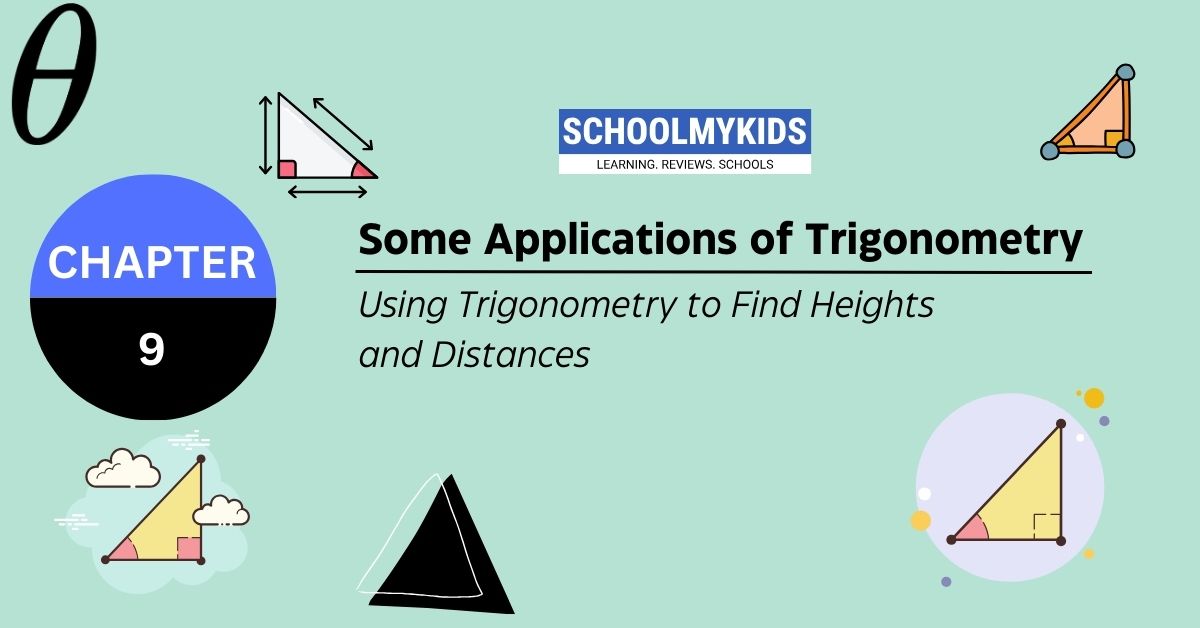This chapter of CBSE class 10th Maths syllabus explores how trigonometry, specifically the concepts of sine (sin), cosine (cos), and tangent (tan), can be applied to solve real-world problems involving heights and distances. We will focus on right-angled triangle scenarios.
Key Formulas
- Sine (sin): sin θ = opposite side / hypotenuse
- Cosine (cos): cos θ = adjacent side / hypotenuse
- Tangent (tan): tan θ = opposite side / adjacent side
Remember:
- θ (theta) represents the angle in the right triangle.
- Identify the opposite, adjacent, and hypotenuse sides based on the given angle.
Examples
1. Finding the Height of a Flagpole
Imagine a flagpole standing upright on level ground. You are standing a certain distance (d) away from the base of the pole, and you measure the angle (θ) that the top of the pole makes with the horizontal ground. You also know your own height (h). You want to find the height (x) of the flagpole.
Solution:
- Sketch a right triangle: The flagpole forms the hypotenuse, the distance from you to the pole is the adjacent side, and the height you want to find (x) is the opposite side.
- Identify the trigonometric ratio based on the known information: We know the adjacent side (d) and need to solve for the opposite side (x). Therefore, we can use the tangent function.
- Set up the formula: tan θ = x / d (opposite side over adjacent side)
- Since you want to solve for x, rearrange the formula: x = d * tan θ
Note: You can measure the angle (θ) using a protractor or a clinometer, and your own height (h) is a known value.
2. Determining the Distance Across a River
You are standing on one bank of a river and want to find the distance (d) across the river to the opposite bank. You can see a tall tree (h) standing on the other side. You measure the angle (θ) that the top of the tree makes with the ground on your side of the river.
Solution:
- Sketch a right triangle: The distance across the river (d) is the hypotenuse, the height of the tree (h) is the opposite side relative to the angle you measured, and an imaginary line along the ground to the base of the tree is the adjacent side.
- Identify the trigonometric ratio: We know the opposite side (h) and need to solve for the hypotenuse (d). Therefore, we can use the sine function.
- Set up the formula: sin θ = h / d (opposite side over hypotenuse)
- Since you want to solve for d, rearrange the formula: d = h / sin θ
Note: You can measure the angle (θ) and the height of the tree (h) if it’s accessible.
3. Calculating the Length of a Guy Wire
A guy wire is a cable used to support a leaning structure, such as a telephone pole. You need to determine the length (L) of a guy wire that will be attached to a pole at a certain height (h) above the ground. The wire will be anchored at a point (d) away from the base of the pole, forming an angle (θ) with the ground.
Solution:
- Sketch a right triangle: The guy wire forms the hypotenuse, the distance from the anchor point to the base of the pole (d) is the adjacent side, and the height of the pole (h) is the opposite side relative to the angle of the wire.
- Identify the trigonometric ratio: We know the adjacent side (d) and the opposite side (h), and need to solve for the hypotenuse (L), which is the length of the guy wire. Therefore, we can use the Pythagorean theorem.
- Pythagorean Theorem: a² + b² = c² (where a and b are the sides and c is the hypotenuse). In this case, a = d (adjacent side) and b = h (opposite side), and c = L (hypotenuse). So, L² = d² + h².
- Take the square root of both sides to solve for L: L = √(d² + h²)
Inclination and Declination Angles
- Inclination Angle: This refers to the angle an object or surface makes with the horizontal ground. It’s often used in contexts like ramps, roofs with a slope, or the angle of a ladder leaning against a wall.
- Declination Angle: In astronomy, the declination angle specifies an object’s position in the celestial sphere relative to the celestial equator.
Trigonometry allows you to calculate these angles or determine other unknown parameters when some measurements are available.
Example:
A wheelchair ramp needs to be constructed with a maximum inclination angle of 12° to ensure accessibility. The desired height (h) of the ramp is 1 meter, and you want to find the minimum horizontal distance (d) the ramp needs to extend from the ground.
Solution:
- Sketch a right triangle: The ramp itself forms the hypotenuse, the horizontal distance (d) is the adjacent side, and the height (h) is the opposite side.
- Identify the trigonometric ratio: We know the opposite side (h) and need to solve for the adjacent side (d). We can use the tangent function.
- Set up the formula: tan θ = h / d (opposite side over adjacent side), where θ is the inclination angle (12° in this case).
- Since you want to solve for d, rearrange the formula: d = h / tan θ
- Plug in the known values: d = 1 meter / tan(12°) (you can use a calculator to find the tangent of 12°).
Note: By ensuring a shallow inclination angle, the ramp becomes easier to navigate for wheelchair users.
Projectiles and Motion
Trigonometry plays a crucial role in analyzing the motion of projectiles launched at an angle. By knowing the initial launch velocity (v) and the launch angle (θ), you can calculate the horizontal distance (d) traveled, the maximum height (h) reached, and other aspects of the projectile’s motion.
Formulas: (These formulas involve additional concepts beyond basic trigonometry and might be introduced in more advanced courses)
- Horizontal Distance (d) = v * cos(θ) * t (where t is the time of flight)
- Maximum Height (h) = (v² * sin²(θ)) / (2g) (where g is the acceleration due to gravity)
Understanding these formulas allows engineers and scientists to model the trajectories of rockets, missiles, and other projectiles.
Bearings and Navigation
In navigation, bearings are used to specify directions. A bearing is the angle measured clockwise from a reference direction (usually north) to a specific point. Trigonometry helps determine bearings and distances between locations based on compass readings and other navigational techniques.
Applications in AC Circuits
In alternating current (AC) circuits, voltage and current can be represented as sine waves. Trigonometry helps analyze these waves, calculate their amplitudes, frequencies, and phase relationships. This is essential for understanding and designing electrical circuits.
Note: This application builds upon concepts of trigonometric functions beyond the scope of this introductory chapter.
Key Formulas
- Sine (sin θ): sin θ = opposite side / hypotenuse (Remember: “S” for “opposite over Slope”)
- Cosine (cos θ): cos θ = adjacent side / hypotenuse (Remember: “C” for “adjacent over Cosine”)
- Tangent (tan θ): tan θ = opposite side / adjacent side (Remember: “T” for “opposite over Touch”)
Note: These ratios are unitless since they represent the relative lengths of sides.
Solving for Heights and Distances (Examples)
Focus: We can use trigonometry to find missing heights or distances in right-angled triangle scenarios by identifying the relevant trigonometric ratio based on the known information.
Examples: (Refer to previous explanations for details)
- Finding the height of a flagpole using the tangent function.
- Determining the distance across a river using the sine function.
- Calculating the length of a guy wire using the Pythagorean theorem.
Beyond Heights and Distances
Trigonometry extends its usefulness to various other applications:
- Inclination and Declination Angles:
- Inclination Angle: Angle an object makes with the horizontal ground (ramps, roofs).
- Declination Angle: Object’s position in the celestial sphere (astronomy).
- Note: Trigonometry helps calculate these angles or other unknown parameters when some measurements are available.
- Projectiles and Motion:
- Analyzing the motion of objects launched at an angle (projectiles, rockets).
- Formulas: (Introduced in more advanced courses) These formulas involve initial velocity, launch angle, horizontal distance traveled, and maximum height reached.
- Bearings and Navigation:
- Specifying directions using angles measured from a reference direction (e.g., north).
- Note: Trigonometry aids in determining bearings and distances between locations.
- AC Circuits (Advanced):
- Representing voltage and current as sine waves.
- Note: Trigonometry helps analyze these waves for amplitude, frequency, and phase relationships (important for electrical circuits).
Summary
This chapter highlights the power of trigonometry in solving practical problems beyond just right triangles. By understanding the core concepts of trigonometric ratios and their applications, you can tackle various scenarios involving heights, distances, angles, and motion. Remember, practice is key to mastering these skills, and trigonometry finds applications in diverse fields like engineering, navigation, and even astronomy.









Be the first one to comment on this story.